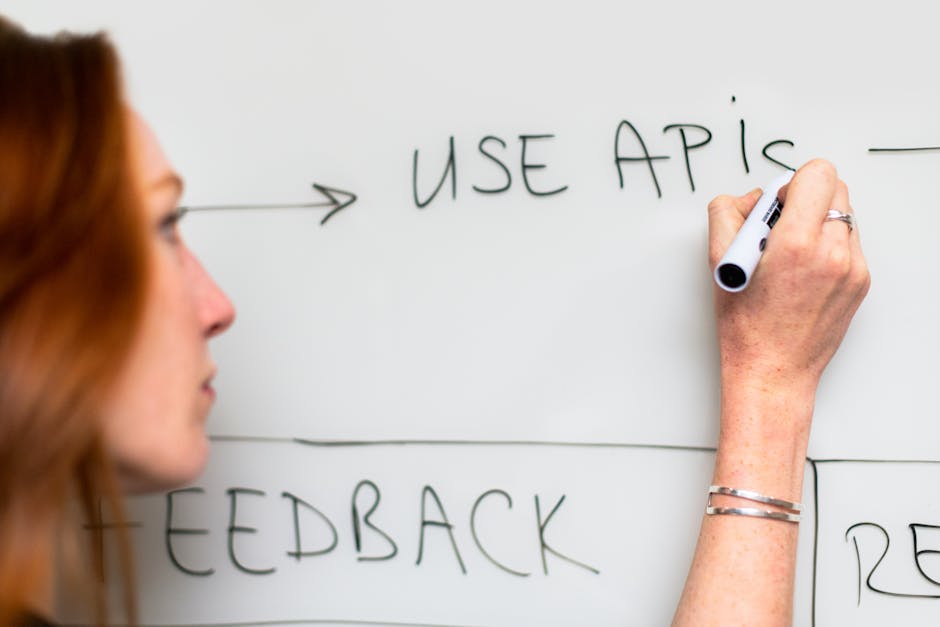The Future of API Development: Trends and Innovations
You’re about to witness the API development revolution, where serverless architecture, event-driven design, and microservices architecture converge to create an era of unprecedented flexibility, scalability, and innovation. Get ready to ditch those expensive servers and hello to cost-effective, scalable, and flexible API development. Quantum computing is on the horizon, and you’ll need to stay ahead of the security threats it brings. But don’t worry, with Kubernetes deployment and orchestration, your APIs will be more resilient than ever. Buckle up, because the future of API development is about to get a whole lot more exciting – and you’re just getting started on this wild ride.
Key Takeaways
• Serverless architecture and cloud-native development enable cost optimisation, flexibility, and scalability in API development.• Event-driven design and microservices architecture facilitate real-time processing, scalability, and efficient API development.• API security measures, such as intelligent routeing and cloud encryption, protect against threats and ensure authorised access.• Kubernetes deployment and orchestration automate container management, ensuring efficient API development and minimising downtime.• Post-quantum cryptography and quantum-resistant algorithms will be essential for securing APIs against quantum computing threats.
Serverless Architecture Revolution

By the time you’re done reading this, you’ll be convinced that serverless architecture is the secret sauce that’s about to disrupt the entire API development landscape. And honestly, it’s about time. The traditional server-based approach has been weighing us down with unnecessary costs and complexity. Serverless architecture is the game-changer we’ve been waiting for.
One of the most significant benefits of serverless architecture is cost optimisation. You only pay for what you use, which means no more idle servers draining your resources. This model allows for massive cost savings, and who doesn’t luv saving money? With serverless, you can allocate your budget to what really matters – developing innovative APIs that change the game.
Another key advantage is function isolation. In a serverless architecture, each function is isolated from the others, which means a single faulty function won’t bring down the entire system. This isolation also enables easier debugging and maintenance, making your life as a developer infinitely easier. No more tedious troubleshooting or 3 a.m. wake-up calls because a single function went rogue.
In a nutshell, serverless architecture is the future of API development. It’s time to ditch the old, clunky server-based approach and embrace the flexibility, scalability, and cost-effectiveness of serverless. Your wallet (and your sanity) will thank you.
Rise of Event-Driven Design

As you venture into the world of API development, you’ll quickly realise that event-driven design is the secret to building scalable, efficient, and flexible systems that won’t leave you pulling your hair out.
It’s like having a superpower that lets you handle a high volume of requests without breaking a sweat. With event-driven design, you can process requests in real-time, making it perfect for applications that require instant responses.
Imagine being able to handle thousands of requests per second without a hiccup – it’s a beautiful thing!
The beauty of event-driven design lies in its ability to decouple services, allowing them to operate independently. This means that if one service goes down, the others can still function seamlessly.
It’s like having a team of superheroes, each with their own unique powers, working together to save the day.
Scalable systems are a breeze with event-driven design. Need to add more capacity? Just spin up more instances and you’re good to go.
It’s like having an army of clones at your beck and call. And the best part? You can process requests in real-time, making it perfect for applications that require instant gratification.
AI-Powered API Gateways

You’re about to level up your API game with AI-powered gateways, which are basically the superheroes of the API world, shielding your system from malicious attacks and performance bottlenecks.
These gateways are the ultimate sidekicks, working tirelessly behind the scenes to safeguard your APIs are secure, scalable, and ridiculously fast.
With AI-powered gateways, you can kiss those pesky performance issues goodby and hello to Intelligent Routeing, which dynamically optimises traffic flow to minimise latency and maximise throughput.
It’s like having a personal traffic cop, redirecting requests to the most efficient endpoint, guaranteeing your users get what they need in record time.
But that’s not all, folks!
These gateways also bring Automated Governance to the table, enforcing security policies and compliance regulations with ease.
No more manual intervention or tedious policy updates – AI-powered gateways got this!
They continuously monitor and adapt to changing traffic patterns, detecting anomalies and potential threats in real-time.
It’s like having a team of expert security analysts working around the clock, minus the coffee breaks and awkward small talk.
With AI-powered gateways, you can finally rest easy, knowing your APIs are protected from the inside out.
So, what’re you waiting for?
Level up your API game and join the AI-powered gateway revolution!
Microservices Architecture Evolution

You’re probably tyred of dealing with clunky, monolithic systems that make your life harder than it needs to be.
That’s where microservices architecture evolution comes in – it’s time to break free from those cumbersome systems and embrace the flexibility of decoupling, service mesh integration, and autonomous team enablement.
Decoupling Monolithic Systems
Breaking free from monolithic systems’ suffocating grip, developers are now rediscovering the joys of scalability and flexibility through microservices architecture, where each service is a separate, self-contained unit.
You’re no longer shackled to a rigid, interdependent system that makes changes a nightmare. With microservices, you can breathe easy, knowing that a single service update won’t bring down the entire system.
As you venture on this journey, you’ll need to tackle domain refactoring – breaking down monolithic domains into smaller, manageable pieces.
It’s like dismantling a puzzle, identifying the individual components, and reassembling them into a more efficient, scalable system. This process is vital for system modernisation, allowing you to upgrade and innovate without disrupting the entire system.
With each service operating independently, you can update, test, and deploy without risking the entire system. It’s time to say goodby to the monolithic mess and hello to a more agile, adaptable architecture.
Service Mesh Integration
As microservices multiply, the complexity of their interactions can quickly spiral out of control, and that’s where service mesh integration comes in – a key step in microservices architecture evolution.
You’re probably thinking, ‘What’s the big deal? I’ve got a bunch of microservices, and they’re all just… servicing away.’ But trust us, it’s not that simple.
Without a service mesh, you’re basically playing a game of microservice Whac-A-Mole – one issue gets fixed, and another pops up somewhere else.
Service mesh integration is the answer to your microservice prayers. It’s like having a super-smart, über-efficient traffic cop, directing traffic flow and ensuring everything runs smoothly.
With service mesh, you get to enjoy the benefits of traffic management, load balancing, and security – the trifecta of microservice harmony.
No more manual intervention or tedious debugging; just pure, unadulterated microservice bliss.
Autonomous Team Enablement
With autonomous teams, you’re no longer stuck in microservices limbo, where a single bottleneck can bring the entire system crashing down. You’re free to scale, innovate, and adapt at lightning speed. This is where the real magic happens – where Cross Functional Roles and Self Organising Teams take centre stage.
Autonomous teams bring many benefits, including:
Decentralised decision-making: No more waiting for approval from the top. Teams make their own decisions, fast.
Domain-driven design: Teams own their domains, and design systems that make sense for their users.
Continuous feedback loops: Teams iterate, learn, and adapt in real-time, no more Waterfall nonsense.
Freedom to experiment: Teams can try new things, take risks, and innovate without asking permission.
Autonomous teams are the future of API development. They’re the key to harnessing true agility, scalability, and innovation. So, ditch the command-and-control approach and let your teams take the reins. It’s time to tap the power of autonomous teams and watch your API development soar!
Cloud-Native API Development

You’re probably thinking, ‘Cloud-native API development, isn’t that just a fancy way of saying ‘I’m tyred of managing servers’?
And honestly, you’re not wrong – with serverless architecture, you can kiss those tedious server management tasks goodby.
Now, let’s talk about how Kubernetes deployment and event-driven design are about to change the API development game.
Serverless Architecture
By ditching servers, you’re basically telling your infrastructure worries to take a hike, and that’s precisely what serverless architecture promises – a cloud-native API development approach that lets you focus on writing code, not babysitting machines.
With serverless architecture, you can kiss those pesky server management tasks goodby and hello to a world of cost benefits and real-time scaling.
Cost benefits: Only pay for the compute time consumed by your code, rather than provisioning and paying for idle servers.
Real-time scaling: Scale up or down in real-time to match changing traffic demands, without worrying about server capacity.
Increased agility: Deploy and iterate on your code faster, without worrying about server provisioning and management.
Reduced administrative burden: Let the cloud provider handle server maintenance, patches, and upgrades, freeing up your time for more important things… like writing code.
Kubernetes Deployment
Now that you’ve ditched those pesky servers, it’s time to take your cloud-native API development to the next level with Kubernetes deployment, where you get to orchestrate your containers like a boss.
With Kubernetes, you can automate the deployment, scaling, and management of your containers, guaranteeing your API is always available and scalable.
Think of it as a symphony conductor, expertly coordinating the performance of your containers to provide a seamless user experience.
You get to define your deployment strategies, deciding how and when to roll out new versions or updates. And with rolling updates, you can minimise downtime and zero interruptions to your users.
Kubernetes takes container orchestration to the next level, allowing you to manage complex deployments with ease.
You can define deployment strategies, like blue-green deployments or canary releases, to facilitate a smooth rollout of new features.
With Kubernetes, you’re in control, and your API development just got a whole lot more efficient.
Event-Driven Design
With event-driven design, your cloud-native API development just got a whole lot more agile, as you can break free from rigid request-response patterns and tap the full potential of microservices architecture. You’re no longer tied to a specific sequence of events; instead, you can design your system to respond to events as they happen, in real-time. This means your API can react instantly to changes, making it more responsive and efficient.
Event-driven design can supercharge your API in several ways:
Real-time processing: With event-driven design, you can process events as they happen, allowing for real-time analytics, notifications, and more.
Asynchronous messaging: Say goodby to blocked requests and hello to asynchronous messaging, where services can communicate without waiting for responses.
Decoupling: Event-driven design lets you decouple services, making it easier to develop, test, and deploy individual components independently.
Scalability: By breaking free from rigid request-response patterns, your API can scale more efficiently, handling a higher volume of requests without breaking a sweat.
With event-driven design, you can create a more agile, efficient, and scalable API that’s ready to take on the demands of the modern digital landscape.
API Security in the Cloud

As you migrate your precious APIs to the cloud, you’re basically handing over the keys to your kingdom to a third-party provider, which raises a plethora of security concerns.
It’s like trusting a stranger with your most valuable possessions – not exactly a comfortable feeling, right?
When you move your APIs to the cloud, you’re basically putting your faith in someone else’s security measures.
But don’t freak out just yet; there are ways to mitigate those risks. Cloud encryption is a great place to start.
By encrypting your data, you’re making it much harder for hackers to get their hands on your sensitive info.
Think of it like locking your kingdom’s gates with an unbreakable chain – even if someone tries to break in, they won’t get far.
Another vital aspect of API security in the cloud is identity verification.
You need to verify that only authorised users can access your APIs.
It’s like having a strict bouncer at your kingdom’s entrance, only letting in those who’ve the right credentials.
This way, even if someone tries to sneak in, they’ll be stopped at the door.
By implementing robust identity verification measures, you can rest easier knowing that your APIs are protected from unauthorised access.
Quantum Computing Impact

You’ve finally secured your APIs in the cloud, but here comes the next potential disruptor: quantum computing, which is about to blow the lid off your carefully crafted security measures, rendering them as useful as a chocolate teapot. Don’t get too comfortable, because quantum computers are about to render your encryption methods obsolete.
Quantum computers can process certain algorithms at incredible speeds, making them a significant threat to your API’s security.
-
Quantum Encryption: Quantum computers can break certain encryption algorithms, but they can also be used to create unbreakable quantum encryption methods. You’ll need to adapt to these new methods to stay secure.
-
Algorithmic Complexity: Quantum computers can solve certain complex algorithms much faster than classical computers. This means they can potentially break certain encryption methods, but also speed up complex calculations.
-
New Attack Vectors: Quantum computers will introduce new attack vectors, such as quantum-powered side-channel attacks. You’ll need to stay ahead of these threats to keep your APIs secure.
-
Post-Quantum Cryptography: You’ll need to start using post-quantum cryptography methods, such as lattice-based cryptography or hash-based signatures, to stay ahead of the quantum threat.
Quantum computing is a game-changer, and you need to be prepared. Start exploring post-quantum cryptography methods and stay ahead of the curve. Your API’s security depends on it.
Conclusion
You’re standing at the edge of a cliff, staring into the abyss of API development’s future.
It’s a formidable view, but don’t worry, you’re not alone.
The landscape is shifting, and you’re about to venture on a wild ride.
With serverless architecture, event-driven design, and AI-powered gateways, the game is changing fast.
Buckle up, because the future of API development is about to go from 0 to 100 in 3 seconds flat.
Hold on tight, it’s gonna be a bumpy ride!
Contact us to discuss our services now!